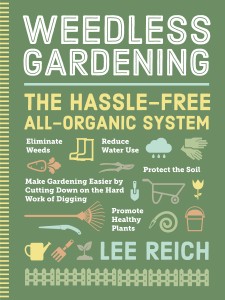Best Books for Building Soil
During the Minnesota State Fair, I gave a talk on the best books for new gardeners. For me, it’s hard to recommend just a few books, so I’ll be posting over the next couple of weeks about other categories of gardening books and my favorites among them.
Today — let’s talk soil, which is the basis of how well your garden grows. The ideal garden soil is loamy—loose textured for air circulation and drainage and filled with nutrients and microscopic life. Unfortunately, many soils in Minnesota are heavily clay, which holds onto water too long, compacts easily and makes it difficult for trees, shrubs and perennials to send out roots. To build better soil, the basic rule is add compost. For a more detailed and complete discussion of building soil, check out these three books.
 Weedless Gardening (Workman Publishing, 2000) by Lee Reich argues that tilling soil annually, which many vegetable gardeners do, encourages weeds and makes gardening more work than it needs to be. Instead, Reich—a regular contributor to Northern Gardener and many other publications—builds the soil from the top by layering on compost and mulch every year and building the soil without disturbing it. Lee wrote an article for Northern Gardener back in 2009 that explains the technique. But, if you really want to embrace weedless (or nearly weedless) gardening, check out the book!
Weedless Gardening (Workman Publishing, 2000) by Lee Reich argues that tilling soil annually, which many vegetable gardeners do, encourages weeds and makes gardening more work than it needs to be. Instead, Reich—a regular contributor to Northern Gardener and many other publications—builds the soil from the top by layering on compost and mulch every year and building the soil without disturbing it. Lee wrote an article for Northern Gardener back in 2009 that explains the technique. But, if you really want to embrace weedless (or nearly weedless) gardening, check out the book!
Gaia’s Garden (Chelsea Green, 2009) by Toby Hemenway is one of the first (and in my view, best) books about permaculture, which is a lower impact style of gardening. Permaculture emphasizes building the soil and using perennial plants to provide fruits and vegetables and beauty in your yard. This guide is nicely illustrated with photos and charts and Hemenway takes the time to explain the science behind many of his recommendations.
Let it Rot! (Storey Publishing, 1998) by Stu Campbell is the classic beginner’s guide to making compos—this is the third edition and the book has been around since the 1970s. How to set up your bins, where to locate them, what to put in them, when to turn and how to use the compost—it covers all the bases.
If soil is an interest (concern?) of yours, another place to check is the University of Minnesota Extension website. Below are a few links to check out — and, it’s always a good idea to get a soil test if you have concerns about your soil.
- Everything about soil in Minnesota
- Backyard compost guide
- Best Plants for Tough Sites from U of M Extension Master Gardeners
—Mary Lahr Schier
